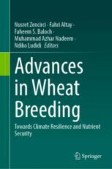Search
Search Results
-
Physiological breeding for yield improvement in soybean: solar radiation interception-conversion, and harvest index
Key messageEfficiency of light interception, Radiation use efficiency and harvest index can be used as targets to improve grain yield potential in...

-
In situ evaluation of stalk lodging resistance for different maize (Zea mays L.) cultivars using a mobile wind machine
BackgroundStalk lodging is an impediment to improving profitability and production efficiency in maize. Lodging resistance, a comprehensive indicator...

-
Exploring the physiological basis of yield enhancement in New Generation Rice (NGR): a comparative assessment with non-NGR rice genotypes
As the research is progressing toward sustainable yield increment with minimal environmental impact, the breeding of New Generation Rice (NGR) has...

-
Impact of Abiotic Stresses on Wheat Growth and Adaptation
Although abiotic stresses have always been important, recent developments due to climate change made them more important than ever. On the one hand,...
-
Genome-wide association study reveals marker–trait associations for major agronomic traits in proso millet (Panicum miliaceum L.)
Main conclusionThe pilot-scale genome-wide association study in the US proso millet identified twenty marker–trait associations for five...

-
Abiotic Stress Tolerance in Wheat: Physiological Interventions
The wheat cultivation across the globe is challenged with different abiotic stresses like drought, heat, salt, lodging, pre-harvest sprouting, etc....
-
Genetic Improvement for Yield, Quality, Biotic, and Abiotic Stresses in Little Millet (Panicum sumatrense Roth. ex Roem. and Schult.)
Small millet, a set of small-seeded crops that includes Finger millet, Little millet, Kodo millet, Foxtail millet, Barnyard millet, and Proso millet,...
-
Genetic diversity and population structure of modern wheat (Triticum aestivum L.) cultivars in Henan Province of China based on SNP markers
BackgroundHenan is the province with the greatest wheat production in China. Although more than 100 cultivars are used for production, many cultivars...

-
Role of Mutation Breeding in Crop Improvement with Special Reference to Indian Subcontinent
The primary source of all genetic variations existing in any organism, including plants and animals, is mutation. Mutation provides the raw material...
-
Vegetation indices as a Tool for Map** Sugarcane Management Zones
In precision agriculture, the adoption of management zones (MZs) is one of the most effective strategies for increasing agricultural efficiency....

-
Correlation analysis of stem hardness traits with fiber and yield-related traits in core collections of Gossypium hirsutum
BackgroundStem hardness is one of the major influencing factors for plant architecture in upland cotton ( Gossypium hirsutum L.). Evaluating hardness...

-
EMS-induced mutagenesis in Choy sum (Brassica chinensis var. parachinensis) and selection for low light tolerance using abiotic stress indices
BackgroundChoy Sum ( Brassica rapa ssp. chinensis var. parachinensis ), grown in a controlled environment, is vulnerable to changes in indoor light...

-
Genetic diversity of selected pigmented traditional rice (Oryza sativa L.) varieties from Mindanao, Philippines using agromorphological traits and simple sequence repeats markers
Philippine pigmented traditional rice varieties (TRVs) offer potential novel genes for genetic improvement. In this study, forty-three pigmented...

-
Foliar Thiourea Confers Moisture Stress Tolerance in Rainfed Maize Through Elevated Antioxidative Defence System, Osmolyte Accumulation and Starch Synthesis Grown Under Different Planting Methods
Moisture stress induced by intra-season and terminal dry spells has been addressed as principal constraint for maize cultivation across the rainfed...

-
LIDAR-Based Phenoty** for Drought Response and Drought Tolerance in Potato
As climate changes, maintenance of yield stability requires efficient selection for drought tolerance. Drought-tolerant cultivars have been...

-
Research Status of Forage Seed Industry in China
Forage germplasm resources are the basis of the original innovation in grass industry and forage breeding, and strategically important to ensure the...
-
Empirical comparison of genomic and phenotypic selection for resistance to Fusarium ear rot and fumonisin contamination in maize
Key messageGS and PS performed similarly in improving resistance to FER and FUM content. With cheaper and faster genoty** methods, GS has the...

-
Pearl millet a promising fodder crop for changing climate: a review
The agricultural sector faces colossal challenges amid environmental changes and a burgeoning human population. In this context, crops must adapt to...

-
Phenotypic characteristics of ramie (Boehmeria nivea L) germplasm resources based on UAV remote sensing
Ramie ( Boehmeria nivea L.) is one of the main fiber crops in China, integrated with textile, forage, building materials and soil conservation....

-
Ancient wheat species are suitable to grain-only and grain plus herbage utilisations in marginal Mediterranean environments
Thanks to their low fertilization requirements and high consumer demand, ancient wheats and old durum wheat cultivars represent an attractive option...

